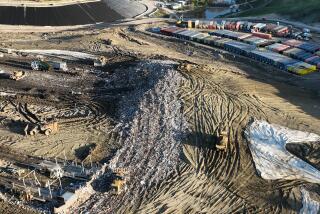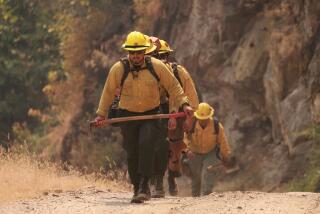Veterans speak out against burn pits
The noxious smoke plumes that wafted over the military base in Balad, Iraq, alarmed Lt. Col. Michelle Franco. The stench from a huge burn pit clung to her clothing, skin and hair.
“I remember thinking: This doesn’t look good, smell good or taste good,” Franco said recently. “I knew it couldn’t be good for anybody.”
She wheezed and coughed constantly. When Franco returned to the U.S., she was diagnosed with reactive airway dysfunction syndrome. She is no longer able to serve as an Air Force nurse.
Other returning veterans have reported leukemia, lymphoma, congestive heart problems, neurological conditions, bronchitis, skin rashes and sleep disorders -- all of which they attribute to burn pits on dozens of U.S. bases in Afghanistan and Iraq.
“The military needs to step up and address this problem,” said John Wilson of the advocacy group Disabled American Veterans, which maintains a registry of more than 500 veterans with disorders they blame on burn pits. The fumes emanating from the pits, he warned, could become the Agent Orange of the current war zone.
Items burned in the pits have included medical waste, plastics, computer parts, oil, lubricants, paint, tires and foam cups, according to soldiers and contractors. Some say amputated body parts from Iraqi patients were burned in Balad, site of a large U.S. military hospital.
A military environmental agency that tested air samples from Balad in 2007 found dioxins, metals, volatile organic compounds and other toxic substances in the smoke. But in its report -- titled “Just the Facts” -- the U.S. Army Center for Health Promotion and Preventive Medicine said the substances “were within acceptable standards.” It also blamed particulate matter found at levels above military exposure guidelines on the blowing sand and dust that is common at bases across the region.
“Although no chemical concerns or significant health risks have been identified, smoke from any source, including burning trash, can still cause temporary irritation effects,” the report said.
Last year, the center recommended moving burn pits downwind from areas where service members live and work, and minimizing the burning of plastics and cooking grease.
According to Lt. Cmdr. Bill Speaks, a military spokesman, the burning of medical waste, fuels, oils, lubricants, tires, most metals, electronics, batteries and other hazardous items is prohibited. More environmental sampling and independent reviews are planned “to ensure . . . an improved understanding of burn-pit smoke and any resulting health risks,” Speaks said.
Still, Army Master Sgt. Tex C.G. Hughes said batteries, computer parts and other banned materials were burned regularly at the main U.S. military base in Kandahar, Afghanistan. He said the fumes wafted over a nearby training camp, where he and other soldiers suffered from burning eyes, coughing and wheezing.
“You could taste the smoke all night long,” said Hughes, a 61-year-old intelligence specialist. He attributes his sleep apnea to smoke exposure.
The Pentagon operates at least 84 burn pits in Iraq and Afghanistan, according to Rep. Timothy H. Bishop (D-N.Y.), who cosponsored legislation last fall that prohibited burning hazardous and medical waste unless the military showed it had no alternative. The law also requires the Defense Department to justify burn pits, develop alternatives and improve medical monitoring.
Two pits at Balad were shut down in October and replaced by four closed incinerators with pollution controls. The military has installed 27 incinerators in Iraq and Afghanistan and has ordered 82 more, Bishop said.
While the Pentagon says the pits do not cause serious long-term health problems, some health experts disagree.
Dr. Anthony Szema, chief of the allergy section at the Veterans Affairs Medical Center in Northport, N.Y., said exposure to smoke and fumes from burning refuse can increase the risk of death from lung cancer or cardiovascular disease. Szema told a Senate Democratic Policy Committee hearing in November that burning plastic bottles produces dioxin and hydrochloric acid, and burning polystyrene foam cups produces dioxin, benzene and other carcinogens.
“In summary, you should not burn trash or inhale burning trash,” Szema said.
And retired Lt. Col. Darrin L. Curtis -- a bioenvironmental engineer who served at Balad in 2006 and 2007 -- told the committee that “burn pits may be responsible for long-term health problems in many individuals who were exposed to the smoke plumes.”
Army Sgt. 1st Class Francis Jaeger, a communications specialist, said he was regularly ordered to haul refuse to a pit at a U.S. base in Tall Afar, Iraq, where it was burned by contractors.
“We were told to burn everything -- electronics, bloody gauze, the medics’ biohazard bags, surgical gloves, cardboard. It all went up in smoke,” said Francis, 46, who attributes his asthma, joint pain, muscle spasms and fatigue to exposure.
Russell Keith, a paramedic working at Balad, said he could tell when the wind had blown dark green plumes from burn pits toward base living areas. He said long lines formed for sick call, with troops coughing up blood, vomiting and complaining of nausea or burning lungs.
Keith said that medical waste, including syringes and expired drugs, was burned in the pits, and that jet fuel was sometimes used as an accelerant. Keith, 50, said he had been diagnosed with Parkinson’s disease, which he blames on toxic smoke.
In January, Bishop and Rep. Carol Shea-Porter (D-N.H.) introduced the Military Personnel Toxic Exposure Registry Act, which would require the Pentagon to create a database of the tens of thousands of troops exposed to burn pits. The bill also would ban burning plastics, require annual reports to Congress on sicknesses, and ensure that veterans affected by the smoke received full service-related health benefits, Bishop said.
More than 280 veterans and contract workers have sued defense contractor KBR Inc., alleging that burn pits it operated on U.S. bases in Iraq and Afghanistan caused cancers, respiratory problems and 13 wrongful deaths, said Susan Burke, lead attorney for the plaintiffs.
Chief Warrant Officer 5 John A. Wester, 59, a Special Forces soldier, blames his Hodgkin’s disease on exposure to a burn pit at the U.S. base in Bagram, Afghanistan.
“The military wants to deny anything’s wrong, just like with Agent Orange,” Wester said. “But there’s no doubt in my military mind where I got my cancer.”
david.zucchino@ latimes.com
More to Read
Sign up for Essential California
The most important California stories and recommendations in your inbox every morning.
You may occasionally receive promotional content from the Los Angeles Times.











